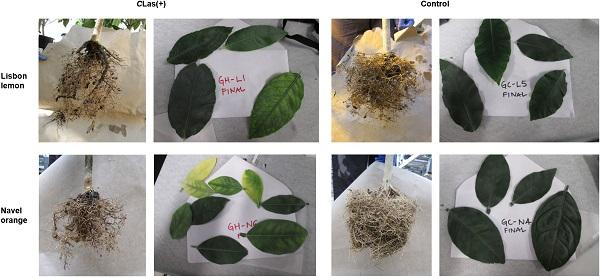
Credit: Emily M. T. Padhi, Nilesh Maharaj, Shin-Yi Lin, Darya O. Mishchuk, Elizabeth Chin, Kris Godfrey, Elizabeth Foster, Marylou Polek, Johan H. J. Leveau, and Carolyn M. Slupsky
Citrus greening disease, or Huanglongbing (HLB), is deadly, incurable, and the most significant threat to the citrus industry. Most HLB research focuses on the tree canopy, but scientists in California studied the impact of HLB on root systems. They recently published the first study to report on the response of two different varieties of citrus to the causal bacterium, ‘Candidatus Liberibacter asiaticus‘ using metabolomics and microbiome technologies.
“Metabolomics is a cutting-edge field of study that provides snapshot information about the metabolism of living things,” explains author Emily M. T. Padhi, “while microbiome studies provide valuable information about the microbial communities living in a particular ecological niche – some microbes are beneficial to the host, while others can be harmful.”
Padhi and colleagues wanted to see how the root system of two varieties of citrus responded to HLB. They collected roots from healthy and infected Lisbon lemon and Washington Navel orange trees grown in greenhouses at the same time and under the same conditions.
They found that both varieties experienced a reduction in root sugars and amino acids when exposed to HLB. However, they also found differences. While the concentration of malic acid and quinic acid (two metabolites involved in plant defense) increased in the navel roots, they decreased in the lemon roots. They also found that the beneficial bacteria Burkholderia increased substantially in navel plants but not in lemons, which contradicts previous studies.
“Overall, this is the first study to compare two varieties of citrus using a combined metabolomics and microbiome approach and demonstrates that scion influences root microbial community composition and, to a lesser extent, the root metabolome.”
There is evidence to suggest that the causal bacterium moves to the root system soon after a plant becomes infected. A key strategy for preserving the health of an infected tree is root system management and research on different responses to HLB may help devise new variety-specific preventative and treatment measures.
###
For more information about this study, read “Metabolome and Microbiome Signatures in the Roots of Citrus Affected by Huanglongbing” published in the December issue of Phytopathology, an international journal publishing articles on fundamental research that advances understanding of the nature of plant diseases, the agents that cause them, their spread, the losses they cause, and measures used to control them.
Media Contact
Ashley Bergman Carlin
[email protected]
651-994-3832
Related Journal Article
http://dx.




